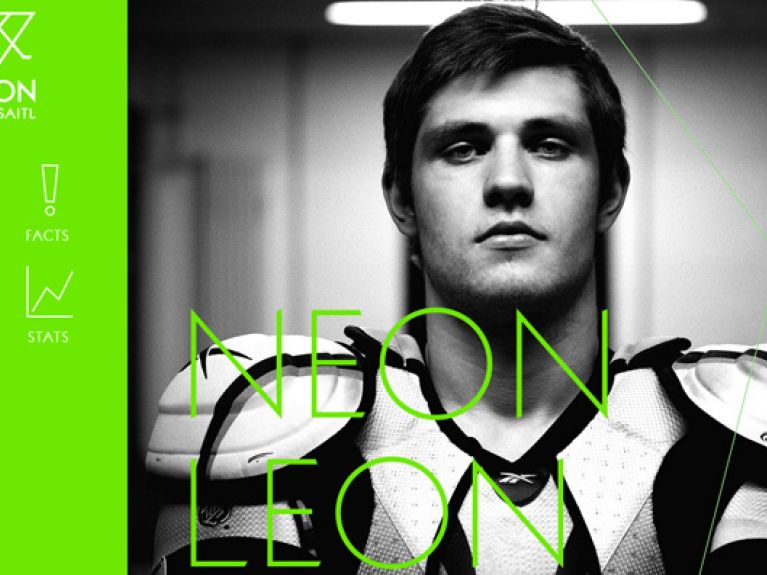The digital society and its friends
Three Germans in North America experience the digital transformation their own way.

Neon Leon“ – the website is a success. Staring at you as he does on his homepage, Leon Draisaitl comes across as rather cool and very futuristic. Wearing his protective ice hockey gear, you think less ‘player for the Edmonton Oilers’ and more ‘man from the future’. And there is indeed some truth behind this, as his sport is pinning great hopes on Draisaitl – an athlete who represents a new era.
When Leon’s father Peter Draisaitl ended his career in 2001 Facebook did not yet exist, and it would be another five years before the very first Twitter message was tweeted. Leon Draisaitl tweets and posts, and the neon green side strip on his homepage features social media icons. In the summer of 2014, before his first season in the National Hockey League (NHL), he emphasised: “Of course I’d love lots of followers and likes.” On Twitter at any rate Draisaitl, still 18 at the time, received a warm welcome from the Oilers’ fans. Be it praise or criticism, the social media certainly speed up responses to athletes’ performances enormously and can also reach the stars directly. When Draisaitl scored his first NHL goal in late October, the Oilers tweeted a photo from the players’ changing room on their official channel: Leon Draisaitl proudly holding the puck with which he scored his first goal up for all to see. Shortly afterwards Edmonton Journal hockey blogger David Staples doubted the overly euphoric praise for the exceptionally talented player, who in the meantime has also been through his first crises with the Oilers.
Excellent networking
It can take time to become established in a new environment. 20 years ago even top officials from the German Fraunhofer-Gesellschaft, Europe’s largest applications-oriented research organization, were not exactly sure about the impact the recently founded “Fraunhofer USA” would make. As the subsidiary celebrates its anniversary in 2014, there are no longer any doubts. “We have every reason to be proud,” says Frank Treppe, the new President of Fraunhofer USA. And he is looking to the future: “We aim to involve German industry in the USA even more closely in our research collaboration efforts and initiate more transatlantic research projects with partners from Germany and the USA, for example Industrie 4.0. Americans are excellent at IT and communications technology, Germans at mechanical engineering and production technology.”
The Fraunhofer-Gesellschaft is regarded as a pioneer of digitally networked production; its success in the USA is very much linked to Frank Treppe’s dedication. When he began studying mechanical engineering in the 1970s, the digital transformation was still a long way away. Nowadays as a research manager Treppe helps to shape it. Before being appointed President of Fraunhofer USA, he was responsible as Vice-President and Chief Operating Officer of the US subsidiary for establishing its extensive network. There are now seven Fraunhofer Centers and two marketing offices working on numerous innovations, though not just in the field of industrial production. The Centre for Experimental Software Engineering in Maryland develops more efficient software and also addresses data security questions. Among other things, the Fraunhofer USA Audio and Multimedia Office in San José markets state-of-the-art audio coding systems; the Fraunhofer Heinrich Hertz Institute in Cambridge, Massachusetts, promotes innovative technologies in the fields of 3D image processing and serial data transmission. It is the Research Centers, however, that are at the heart of the Fraunhofer work in the USA. As Frank Treppe emphasizes: “The Centers have close links with excellent universities in the country and, just like the German Fraunhofer Institutes, develop tailor-made solutions for industry.”
Internet connection from the “Soofa” bench
Boston, the city in which Fraunhofer USA recently celebrated its anniversary, now boasts a smart German-US future solution by the dozen: the “Soofa”, a park bench with a wireless connection and charging station, all solar-driven. The special seating was developed by a company called “Changing Environments”, which was founded by three women from Germany: Jutta Friedrichs, Sandra Richter and Nan Zhao.
Digital networking is particularly environmentally friendly with the “Soofa” bench, which has sensors that can also measure noise levels and air quality, thereby raising ecological awareness. The concept has already won over the City of Boston. CEO Sandra Richter says there have also been inquiries from South America, China, and Germany. In an interview with the German online magazine “jetzt.de” she said recently: “I’m a child of nature myself, I come from the Black Forest. I love being outside. Nonetheless, through my network I can reach the whole world, my telephone is my key to information: not just work-related but for private research as well.” With Changing Environments Sandra Richter would like to develop furniture for the cities of the future. The success of the “Soofa” bench is encouraging: At the White House Maker Faire the young entrepreneur was able to talk to President Obama about her ideas. She is not getting over-confident though, hoping rather that she and her colleagues are successful with other innovations, too: “Making cities fit for the future is an enormous challenge.”

